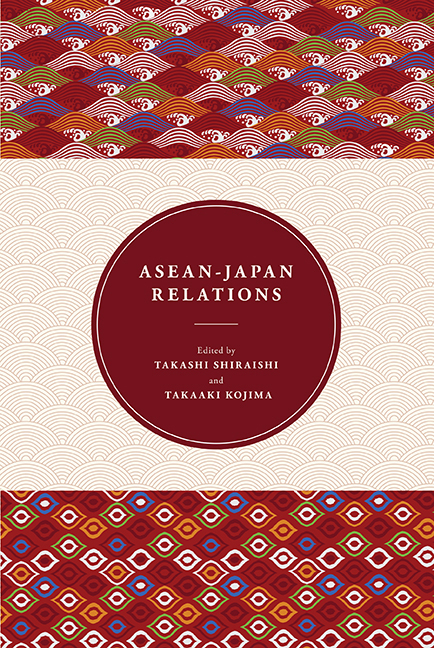Book contents
- Frontmatter
- Contents
- Preface
- About the Contributors
- 1 An Overview of Japan-ASEAN Relations
- 2 Japan's Relations with ASEAN
- 3 Approaches toward Regionalism: Japan, China and the Implications on ASEAN
- 4 The New Japan-ASEAN Partnership: Challenges in the Transformation of the Regional Context in East Asia
- 5 ASEAN-Japan Strategic Partnership and Regional Integration: Impacts and Implications
- 6 ASEAN-Japan Cooperation on Maritime Non-Traditional Security Issues: Toward a New Paradigm
- 7 Japan's Evolving Security Concerns in Maritime Southeast Asia: From Safety of Navigation to “Lake Beijing”
- 8 Evolution of Institutions and Policies for Economic Integration in East Asia: The Rise of China and Changes in the Regional Order
- 9 Managing Integration in East Asia: Behind Border Issues in Japan-ASEAN Trade Agreements
- 10 Regional Financial Cooperation in East Asia: Development and Challenges
- 11 Japanese Development Assistance to ASEAN Countries
- 12 Japanese Foreign Direct Investment in the ASEAN-4 Countries
- 13 Japan's Triple Tsunami
- 14 ASEAN-Japan Relations: A Singapore Perspective
11 - Japanese Development Assistance to ASEAN Countries
Published online by Cambridge University Press: 21 October 2015
- Frontmatter
- Contents
- Preface
- About the Contributors
- 1 An Overview of Japan-ASEAN Relations
- 2 Japan's Relations with ASEAN
- 3 Approaches toward Regionalism: Japan, China and the Implications on ASEAN
- 4 The New Japan-ASEAN Partnership: Challenges in the Transformation of the Regional Context in East Asia
- 5 ASEAN-Japan Strategic Partnership and Regional Integration: Impacts and Implications
- 6 ASEAN-Japan Cooperation on Maritime Non-Traditional Security Issues: Toward a New Paradigm
- 7 Japan's Evolving Security Concerns in Maritime Southeast Asia: From Safety of Navigation to “Lake Beijing”
- 8 Evolution of Institutions and Policies for Economic Integration in East Asia: The Rise of China and Changes in the Regional Order
- 9 Managing Integration in East Asia: Behind Border Issues in Japan-ASEAN Trade Agreements
- 10 Regional Financial Cooperation in East Asia: Development and Challenges
- 11 Japanese Development Assistance to ASEAN Countries
- 12 Japanese Foreign Direct Investment in the ASEAN-4 Countries
- 13 Japan's Triple Tsunami
- 14 ASEAN-Japan Relations: A Singapore Perspective
Summary
INTRODUCTION
Japan has been promoting bilateral economic cooperation with the Association of Southeast Asian Nations (ASEAN) member countries (ASEAN countries) since the 1960s, using development assistance as a major tool. In recent years, Japan has also enhanced regional cooperation with ASEAN. Shimomura (2013) noted that Japan's economic cooperation with East Asia, including ASEAN countries, produces “synergy effects of trade, investment and aid” and considered that this approach is common in the economic cooperation of other Asian countries such as China. This paper provides an overview of Japan's development assistance to ASEAN countries, its relationship with Japan's foreign direct investment (FDI), and other characteristics of Japan's development assistance, such as supporting a balanced urban and rural development. Lastly, recent developments in Japan's regional cooperation with ASEAN are outlined. As a reference, China's external economic cooperation is also described briefly in the footnotes.
IMPACTS OF DEVELOPMENT ASSISTANCE TO ASEAN COUNTRIES
This paper begins with an introduction to some of the previous studies on the impact of Japan's development assistance to ASEAN countries. Kawai (2005), in his report on a coherent policy for development, states that “the economic development of developing countries in East Asia since the 1980s was made possible by the inflow of FDI from developed countries and the subsequent activation of regional specialization and trade.” He points out that “there are links between the development of infrastructure in Asian developing countries supported by Japan's development assistance, the increase in Japanese FDI as a result of Japanese manufacturing companies entering those countries, the increase in exports of industrial products by those countries due to the increase in the intra-company division of labor and transactions, and the increase in household income in those countries.” He concluded that “Japan's development assistance policy, which focused on infrastructure development, was coherent with the strategies of the developing countries in the region, which had promoted export-oriented and industrialization policies.”
Meanwhile, Kimura and Todo (2010) scrutinized the role played by development assistance in inducing FDI. They classified the FDI-inducing effects of the cumulative amount of development assistance of the five main OECD countries4 from 1990 to 2002 into three types — “positive infrastructure effect”, “negative rent-seeking effect”, and “positive vanguard effect” — and performed an empirical analysis using the Gravity Model.
- Type
- Chapter
- Information
- ASEAN-Japan Relations , pp. 207 - 236Publisher: ISEAS–Yusof Ishak InstitutePrint publication year: 2013

